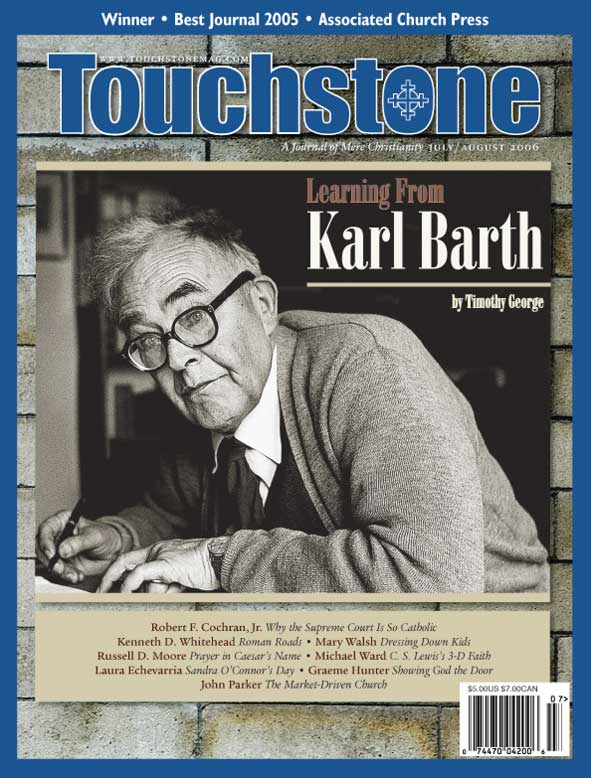The Unfit To Be Tied
Margaret Sanger’s Eugenic Legacy:
The Control of Female Fertility
By Angela Franks
McFarland and Company, 2005
(352 pages, $39.95, paperback)
reviewed by Anne Barbeau Gardiner
Before this book, there has been a strange academic silence about Margaret Sanger’s commitment to what she herself called “negative” eugenics. Angela Franks, a feminist scholar inspired by Germaine Greer and Jean Bethke Elshtain, among others, and a doctoral student in systematic theology at Boston College, proves that eugenic elimination of those she considered “unfit” was the key motivation behind Sanger’s campaign for birth control.
In this eye-opening and thoroughly documented book (there are a hundred pages of notes), Franks persuades the reader that it is a mistake to describe Sanger as a feminist, since from 1917 to the end of her life, she was utterly devoted to eugenics, and her vision of the “free woman” was in fact that of an “engineered and infertile woman” serving the ends of the medical, pharmaceutical, and political establishments.
Sanger railed against the “wickedness of large families” out of fear that the poor would flood the world with “cheap” human beings. She blamed the poor for “creating slums” and filling institutions with dependents.
Such people, she wrote in 1925 in an essay titled “The Need of Birth Control in America,” “have done absolutely nothing to advance the race one iota. Their lives are hopeless repetitions. All that they have said has been said before; all that they have done has been done better before. Such human weeds clog up the path, drain up the energies and the resources of this little earth. We must clear the way for a better world; we must cultivate our garden.”
Preventing the appearance of such “weeds” was her answer to human suffering. Franks sums up Sanger’s message to women thus: “Your mothering is a burden to you and a threat to the world.” To solve this problem, women would have to place themselves, or be placed, under the control of doctors and eugenicists.
Eugenic Core
A dues-paying member of the American Eugenics Society (AES) to the end of her life (she died in 1966), Sanger worked “very closely” in the birth-control movement with many who were leaders in eugenics here and abroad. Some argue that she had only a superficial connection with eugenics, but Franks gives evidence that it was her core principle.
Sanger succeeded where the AES failed because her groundbreaking strategy was to advance eugenics and sexual freedom together. She offered working-class women the same sexual freedom with birth control that rich women already had, foreseeing that the result would be fewer working-class children. As Franks puts it, “Eugenic unfreedom would feel like liberation.”
Sanger’s chief mentor was an Englishman. After leaving her first husband in 1914 and starting up a birth-control magazine that brought down the law on her, she fled to England, where she hobnobbed with the elderly Havelock Ellis, one of the new “sex reformers” who gave intellectual support to her view of sexual freedom.
He, too, regarded women’s fertility as controllable, but the sex drive as uncontrollable. Moreover, he treated birth control and population control as conjoined twins: He wanted the “lowest social stratum”—the poor and those receiving public assistance—to use birth control or be sterilized in a program that would be carried out by the “very best classes.”
It was he who confirmed Sanger in her idea of birth control as a form of elitist eugenics. All humans may be equally animals in the eyes of atheists like Ellis or Sanger, but as Orwell says, some animals are more equal than others.
As Sanger wrote in her The Pivot of Civilization in 1922, because everyone can vote, the growth in numbers of the poor means that “the representatives of this grade of intelligence . . . may destroy our liberties, and . . . may thus be the most far-reaching peril to the future of civilization.” Birth control “is nothing more or less than the facilitation of the process of weeding out the unfit, of preventing the birth of defectives or of those who will become defectives.”
When Sanger left New York, she was an anti-capitalist street fighter; when she returned in 1916, she was ready to become the darling of the rich and famous.
A New Celebrity
She started her first birth-control clinic in an area of Brooklyn full of immigrant Jews and Southern Italians, the very sort whose fertility alarmed eugenicists in her day. After going to jail for it, she was suddenly surrounded by a coterie of a hundred high-society women, who made her a celebrity.
By 1921, she had created the American Birth Control League (ABCL), which would become Planned Parenthood. Her dedication to eugenics can be seen in the founding documents, which describe the “healthy” classes as burdened with the cost of “those who should never have been born.” From the late 1920s she fought to overthrow the Comstock Act of 1873, which barred the distribution of contraceptives, and after achieving this, she began to fight for government funding of contraceptives in public-health programs.
Meanwhile, Sanger got ample funds from some of the richest men in America, devotees of eugenics like the Rockefeller family, who “knew that eugenics and birth control were a package deal.” In the 1920s John D. Rockefeller III gave Sanger as much as $15,000 a year, and in the 1930s decided to concentrate his money in this area. Rockefeller would later join Ford, Scripps, Mellon, and Carnegie in promoting population control. From the viewpoint of eugenics, charity allowed the “unfit” to multiply, so in 1923, the AES stood against increased educational help for the mentally disabled, demanding that the government sterilize them instead.
Franks provides the biographies of several of Sanger’s colleagues to demonstrate how deeply she was implicated in eugenics. One of these was Clarence Gamble, an heir to the Procter and Gamble fortune, who supported the formation of twenty local sterilization clinics in the South and Midwest to promote eugenic sterilization of welfare recipients and the institutionalized. Among his dying words were: “survival of the fittest.”
Another was Dorothy Brush, who boasted that her family fortune would stop suffering at the “source” by “breeding out the unfit.” She also funded the development of amniocentesis “for the prevention of disability”—a phrase that turns the unborn child into a disability prevented by abortion.
Rich Gods
The picture Angela Franks draws of ultra-rich men devoting their wealth to eugenics is disturbing. Who commissioned them to play God? In the 1960s, using a “good-old-boy network,” they lobbied to get federal funding for birth control in the name of the War on Poverty. As a result, Medicaid began funding sterilization of low-income women in 1966, especially in the Indian Health Service, where the program became, in Franks’s description, “genocidal.”
In 1967, some wealthy men, along with officials of the International Planned Parenthood Federation (IPPF), decided that the United Nations needed to promote population control (the name given to eugenics after Hitler’s use of it). They formed the United Nations Fund for Population Activities (UNFPA), which was only later authorized by the General Assembly, and not without controversy.
This sort of presumption can be seen today in Ted Turner, who has spent one billion dollars in population control, including supplying funds for media programs to change “cultural norms” regarding the family. Franks recounts how in 1996, at a Zero Population Growth dinner, Turner called those opposed to population control “the forces of ignorance and darkness” and urged every woman to have only one child for the next century, to reduce the world’s population to two billion. Warren Buffett gave $2 million for the development of the abortion pill RU-486.
Franks argues also that, with its long tentacles, eugenics reaches far into even the “scientific” research done by demographers, because organizations like the UNFPA, IPPF, and USAID demand that researchers seeking funds should favor population control. “Demography generates an indispensable aura of scientific legitimacy for the population-control movement” which, from the beginning, was a “eugenic initiative.”
Thus, the unanimity of the demographers that population growth will have only destructive, even catastrophic effects, is due to the unanimity of the “major donors.” What masquerades as science is, Franks argues, a patronage system.
Coercive Liberalism
Most alarming of all is how eugenicists have always tolerated coercion. Margaret Sanger never condemned the use of coercion to promote birth control or sterilization as a method of final resort when the “unfit” would not accept voluntary control. Today the IPPF and the UNFPA both support China’s program of compulsory sterilizations and abortions.
In this country, Franks notes, it came to light in the 1970s that tax-supported family-planning clinics were sterilizing poor people “unknowingly or forcibly under Medicaid laws.” A federal district judge ruled in the Relf case in 1974 that there was incontrovertible proof that “an indefinite number of poor people have been improperly coerced into accepting a sterilization operation under the threat that various federally supported welfare benefits would be withdrawn.”
No protest was heard from Sanger’s intellectual descendants.
Franks notes that such groups also pursue indirect coercion, as when PPFA engages in million-dollar ad campaigns to guide public opinion about “choice,” or when professionals engage in “genetic counseling” and determine what is in the pregnant woman’s “best interest,” or when a physician acts as “eugenic gatekeeper” and judges an unborn child’s “potential quality of life.” Too frequently, the powerless are “quietly coerced” into their supposed “choice.”
Franks documents extensively how women here and abroad have been used as unwitting guinea pigs in the development of contraceptives like the IUD, Norplant, and Depo-Provera. Once in place, these long-term controls on fertility are out of a woman’s power to remove. Is this really choice, autonomy, and reproductive rights?
Enslaving Freedom
Margaret Sanger and her successors draw women with ideas of freedom only to enslave them, often for eugenic reasons, to doctors, pharmacists, and abortionists. In this way, as the author notes, “under cover of liberalism’s fundamental principles of equality and autonomy, a lethal elitism can work its dark will.”
Such lethal elitism can be found in eugenicist Frederick Osborn, who declared, looking back on the decades of his collaboration with Sanger: “Birth control and abortion are turning out to be great eugenic advances of our time. If they had been advanced for eugenic reasons it would have retarded or stopped their acceptance.”
More on Margaret Sanger may be found at www.angelafranks.com/margaret/index.htm.
Anne Barbeau Gardiner is Professor Emerita of English at John Jay College of the City University of New York. She has published on Dryden, Milton, and Swift, as well as on Catholics of the 17th century.
subscription options
Order
Print/Online Subscription

Get six issues (one year) of Touchstone PLUS full online access including pdf downloads for only $39.95. That's only $3.34 per month!
Order
Online Only
Subscription

Get a one-year full-access subscription to the Touchstone online archives for only $19.95. That's only $1.66 per month!
bulk subscriptions
Order Touchstone subscriptions in bulk and save $10 per sub! Each subscription includes 6 issues of Touchstone plus full online access to touchstonemag.com—including archives, videos, and pdf downloads of recent issues for only $29.95 each! Great for churches or study groups.
Transactions will be processed on a secure server.
more from the online archives
calling all readers
Please Donate
"There are magazines worth reading but few worth saving . . . Touchstone is just such a magazine."
—Alice von Hildebrand
"Here we do not concede one square millimeter of territory to falsehood, folly, contemporary sentimentality, or fashion. We speak the truth, and let God be our judge. . . . Touchstone is the one committedly Christian conservative journal."
—Anthony Esolen, Touchstone senior editor









